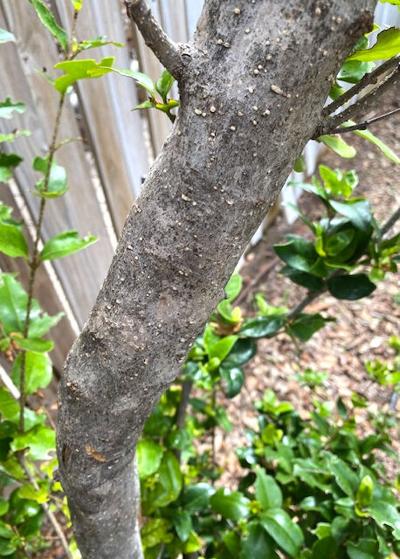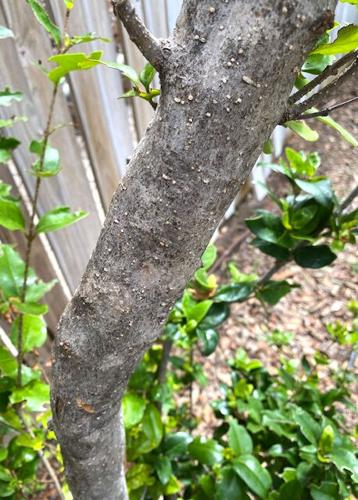Dear Neil: My red oakĐÔĘӽ紫ý™s leaves still havenĐÔĘӽ紫ý™t turned colors and there has been almost no leaf drop so far. That is far different from other years. Why would that happen?
Oaks vary greatly genetically. YouĐÔĘӽ紫ý™ll see that in the growth forms of live oaks, and youĐÔĘӽ紫ý™ll see it in the fall color of red oaks. One season they will be bright red, and the next year theyĐÔĘӽ紫ý™ll just turn brown. Some years they fall normally. Other years they hang in place on the trees all winter long. And not all trees will behave the same way. ItĐÔĘӽ紫ý™s all in the genetics.
Dear Neil: What is this tree (or shrub), and what might be eating its leaves? Are the specks on the trunk part of the bark? They are on every branch and the trunk.
IĐÔĘӽ紫ý™m pretty sure you have a waxleaf ligustrum with leftover freeze injury. It appears the leaf damage could have been caused by a leaf cutter bee. Females of that insect cut perfect semi-circles off the edges of leaves. Without eating any of the leaf tissues, they use those pieces to construct nests in abandoned faucets, downspouts, siding and other constricted spaces. You may not be aware of the nests until you turn on the faucet and a wad of dried leaves blows out all over your shoes. There is really no control for this pest since itĐÔĘӽ紫ý™s not feeding on the host plant and since youĐÔĘӽ紫ý™ll rarely see it in real life. Luckily, it does no permanent damage. The white spots are normal parts of the bark.
Dear Neil: I noticed last night that I had about a dozen hammerhead worms crawling onto my porch. They were 1 to 2 inches long. IĐÔĘӽ紫ý™ve read they could be poisonous, and I do have a dog. Should I be concerned?
I think ĐÔĘӽ紫ýśconcernedĐÔĘӽ紫ýť is a good word, not ĐÔĘӽ紫ýśworried.ĐÔĘӽ紫ýť They use a neurotoxin to kill their prey (our beneficial earthworms) so we definitely do not want to have them in our soils. The ones you saw are comparatively small (young). IĐÔĘӽ紫ý™ve seen them on walks where they were 6 to 8 inches long, and theyĐÔĘӽ紫ý™re somewhat frightening looking. For anyone unfamiliar with them, think of a flattened earthworm with a shovel-shaped head. They were brought into the United States, probably in potting soil, many decades ago. They do not cause much reaction to humans, dogs or cats other than perhaps mild nausea or tingling of the hands should you touch them. Still, you donĐÔĘӽ紫ý™t want them around.
Cutting them to kill them does not help, because the parts can regenerate new worms. Instead, pick them up with a stick and put them into a glass jar where you can pour vinegar in on top of them to kill them.
Dear Neil: I have a small volunteer pecan tree that I tried to remove by cutting 1 foot beneath the soil line. It has now resprouted. I have other plants 6 feet and farther away. What can I do to eliminate the pecan without harming the other plants?
One option would be to dig deeper. Once you get to a point where the taproot branches out and all you have is side roots, that should stop further sprouting. Or you could apply a broadleafed weedkiller to the new growth in May. At the outset, when all you had was the cut stump, you could have drilled into the stump and filled the drill hole with any product containing 2,4-D at full strength. It would have soaked into the wood and been carried out through the roots. But now that youĐÔĘӽ紫ý™ve cut away so many of the deep roots, that probably wonĐÔĘӽ紫ý™t be an option. YouĐÔĘӽ紫ý™re going to have to resort to spraying the growth with the same material diluted with water until you have it at spraying strength.
Dear Neil: What is this fungus in my St. Augustine?
This is a picture-perfect example of brown patch fungus. Although I mentioned it a couple of weeks ago here, it is so prevalent, and your photo is so good that I have decided to include it again. Those yellowed blades will pull loose easily from the runners. They will be decaying where they attach to the runners, and the affected blades will soon turn brown. The good news is that the disease does not attack the runners or the roots, so the grass can recover. However, the fungus, now being called ĐÔĘӽ紫ýślarge patchĐÔĘӽ紫ýť by some university turf and pathology experts, does weaken the grass. You do want to limit its spread. The fungicide Azoxystrobin is your best consumer product for that purpose.
Dear Neil: I am going to replace my burned-out zoysia with mulch, pathways and low-water-use plants. IĐÔĘӽ紫ý™ve been given varying opinions about using weed-blocking mesh beneath the mulch. ItĐÔĘӽ紫ý™s 1,800 square feet. IĐÔĘӽ紫ý™ve been recommended both biodegradable and regular weed-stopping material, as well as no weed-blocking material at all. IĐÔĘӽ紫ý™m willing to spray any weedkiller except Roundup if weeds come along. What do you think?
You asked my opinion, so IĐÔĘӽ紫ý™m going to shift that to what I would do if this were my landscape. I would still have a limited amount of turfgrass. IĐÔĘӽ紫ý™d probably switch over to common bermuda if it were full sun, and IĐÔĘӽ紫ý™d reduce the area by a good bit to reduce your maintenance. Turf has wonderful cooling effects, and we Texans need that.
I do not have any concerns recommending the original Roundup or other glyphosate-only herbicides. Glyphosates got a bad rap that was proven inaccurate by extensive testing. Glyphosates will kill emerging weeds in mulch beds without contaminating the soil. If you spot-treat with glyphosates you will be using a tiny amount and doing so very efficiently.
That said, I would probably not feel the need to use a weed-blocking fabric. I am a big fan of small river rock (golf ball to tennis ball sized) as a mulch, although I also use finely ground pine bark mulch as well. And then attractive, well-adapted groundcovers in tandem with shrubs of equal merit.























